
Marketing chatbots: The marketer that’s always on
Main illustration: Vinnie Neuberg
You might think chatbots are only for customer support, but using them to answer your customers’ questions is just one way to leverage chatbots. With the right setup, a chatbot can power your marketing as well so you never miss a lead.
Website visitors are 82% more likely to convert to customers if they’ve chatted with you first. So, if you’re looking for ways to make your marketing strategy more effective, live chat is the way to go. But how do you staff live chat for your marketing without ballooning your headcount? By using marketing chatbots. Here’s an in-depth look at how they can be used to engage visitors browsing on your website and turn them into leads for your sales team.
What is chatbot marketing?
Chatbot marketing is a marketing technique that employs computer programs to automate interactions with prospects and customers, either on your website or in your app, for the purpose of generating sales. Using chatbots in marketing strategies allows companies to qualify and engage with leads at all hours and at any capacity regardless of whether or not your marketing and sales team are online. Just like how you can use marketing chatbots to answer support questions, you can use chatbots to start conversations with website visitors, qualify leads, and even upsell customers.
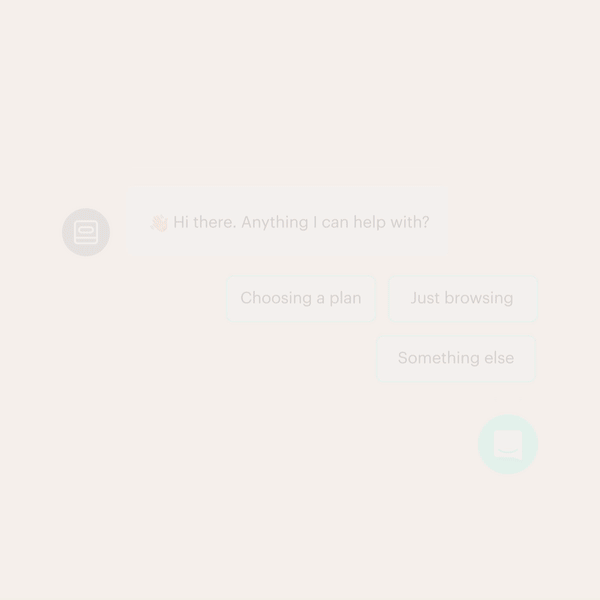 The chatbot on our website
The chatbot on our website
Messenger chatbots aren’t powered by a human, they are built by one. They send your leads and potential customers the exact messages you want them to see based on rules you define. So, for example, if you want your bot to only appear to website visitors who aren’t signed in, you can do that. Or if you want it to appear to visitors who aren’t signed in and have been viewing your pricing page for longer than 30 seconds, you can do that, too.
Benefits of using chatbots for marketing
The beauty of chatbots is that they’re constantly running. They’ll keep your marketing engine going when your team members are unavailable and save them time when they’re hard at work. Here are the key aspects of digital marketing channels that chatbots can automate:
- Engage and qualify leads. Use your marketing chatbots to show website visitors a simple prompt – like “Let us know if you have any questions” – or even a welcome video to open up the door for conversation. Bots can then ask further questions to collect basic qualification details like email and company size. Use these details plus those gathered from data enrichment tools to segment your users and personalize their next steps. For instance, encourage a first-time visitor to sign up for your newsletter but nudge return visitors to book a demo.

- Send high-intent leads directly to sales. Visitors who spend time on your pricing page or click the “Get more info” button likely have a serious interest in your product. Use your chatbot to instantly qualify and book a call with your sales team.
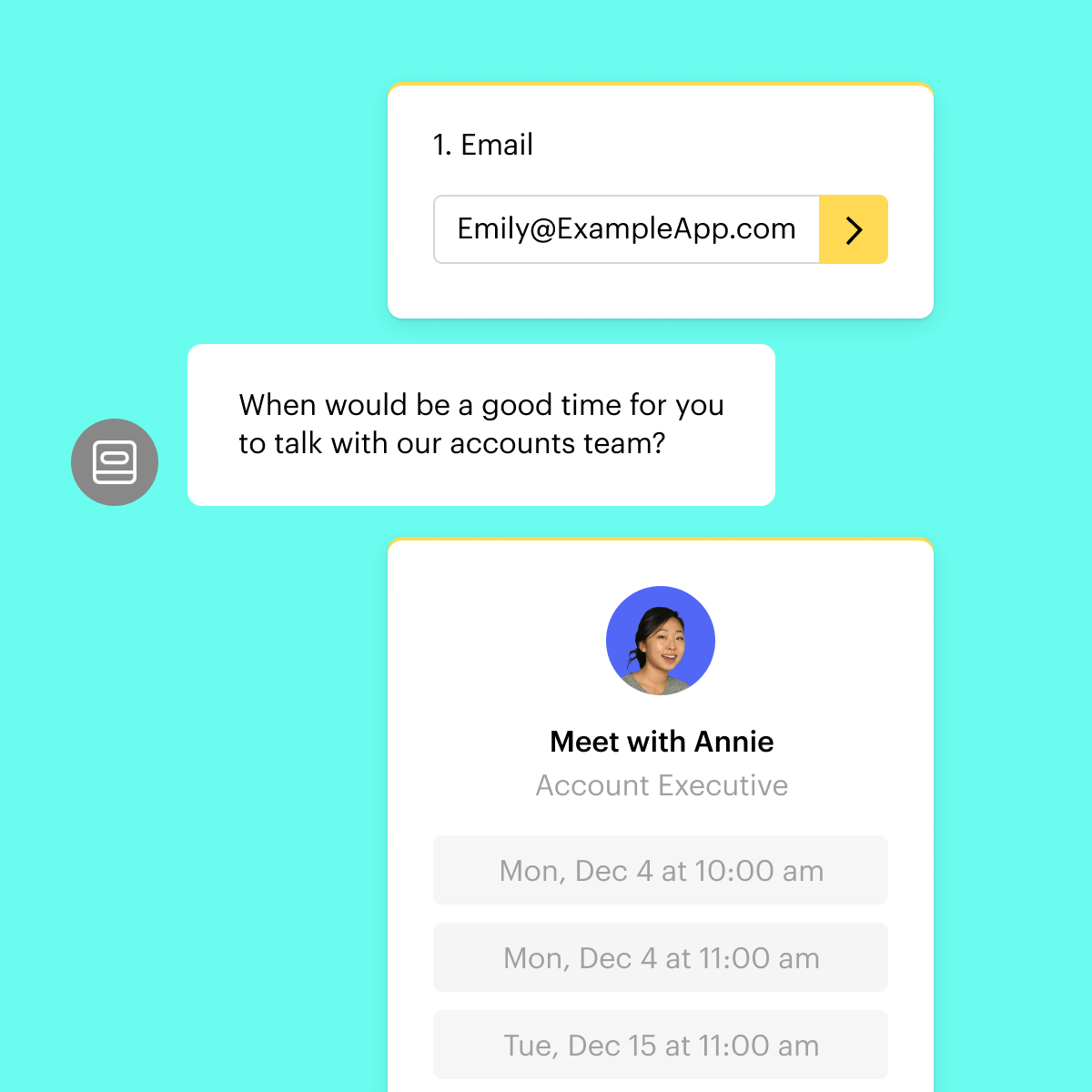 Our chatbots can invite leads to book meetings directly.
Our chatbots can invite leads to book meetings directly.
- Nurture and upsell users. If you offer free trials, bots can offer help to users who haven’t completed their setup and check in with people whose trials are about to end. For customers, let them know about new features and connect them to the Sales reps if they’re interested in upgrading.
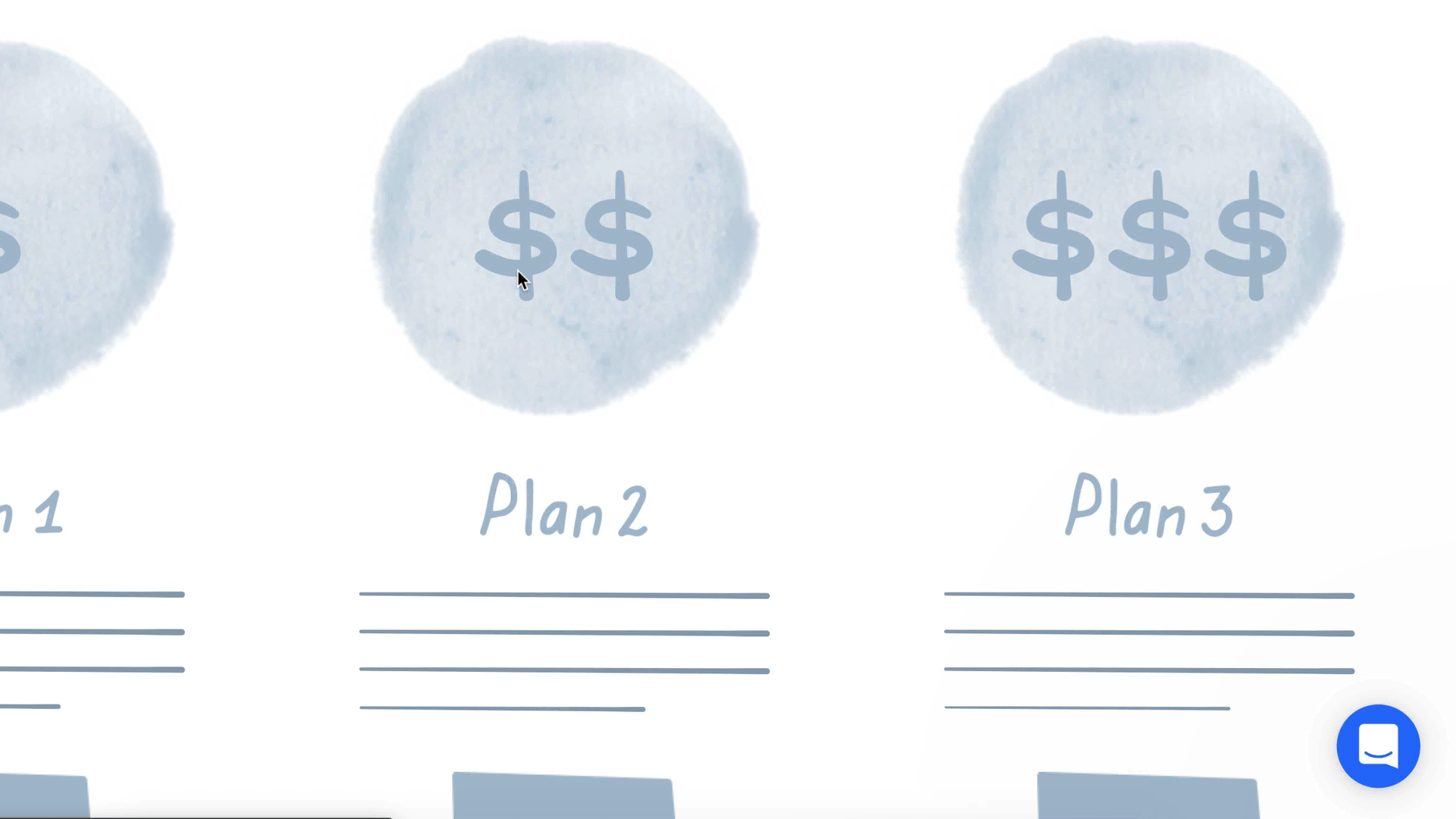 Trigger nurture and upsell messages via chatbots.
Trigger nurture and upsell messages via chatbots.
Chatbot marketing examples in the wild
Chatbot technology has advanced to a stage where they can easily replace traditional web forms on your site and offer users a simpler way to get in touch with you. Let’s take a look at a few examples.
How a Volvo dealership uses bots to provide custom quotes
One of the coolest examples of chatbot marketing that we’ve seen comes from Volvo Cars Amberg, a German car dealership. More and more, potential car buyers visit dealership websites to research prices, so the company placed a marketing chatbot with an integrated Typeform survey on their site to provide an instant, totally customized price quote based on visitors’ input.
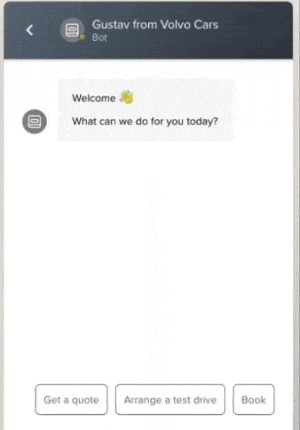 The Volvo dealership’s chatbot provides instant price quotes to website visitors.
The Volvo dealership’s chatbot provides instant price quotes to website visitors.
Here’s the impact the chatbot had on the dealership’s bottom line, according to their marketing manager Tobias Wamser:
“We were able to increase lead generation on our website by about 300%. We are also able to prioritize high-quality leads and offer them an even more personalized experience”
Not only that, but leads coming through the Volvo dealership’s chatbot are 200% more likely to purchase a vehicle than those acquired via their contact form, since they’re able to get immediate answers to their questions or book a test drive online.
How we use chatbots for marketing at Intercom
Chatbots are a key component of our marketing at Intercom, too. We use chatbots on all the key pages of our site, including our pricing page, demo page, and even the blog you’re currently reading this article on!
If you visit our pricing page, our bot will pop up almost immediately, asking how we can help. Answer the questions, and you’ll be offered a suggestion for the plan that fits you best, plus the opportunity to chat with someone from our team to learn more.
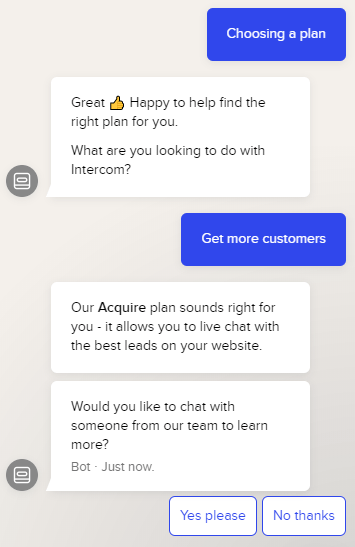 The chatbot on our pricing page
The chatbot on our pricing page
Using AI-driven marketing chatbots allows our team to qualify leads 24/7 and instantly move them to the next step with minimal manual input. You can also set up chatbots to talk with customers over social media apps like Facebook Messenger. And because our bots ask multiple qualifying questions and respond to the answers, we know what that next step is — whether it’s a piece of content or a conversation with sales.
Check out more examples of companies using our chatbots to improve their marketing in this article or in our case studies.
How to set up marketing chatbots with Intercom
Ready to give chatbots a try? If you’re not using Intercom yet, first sign up for a free trial.
We offer simple task bots that you can set live in minutes to automatically collect visitors’ contact details whenever they start a conversation with your team. Our “Qualify leads” task bot can also follow up in the same conversation to ask simple qualification questions.
To proactively engage visitors on your site and offer a more personalized customer experience, try our Custom Bots. While Custom Bots answer the simple questions (and seamlessly route the not-so-simple ones to the right people), your teams can focus on the complex queries that have a greater impact, building customer trust and loyalty. Follow these three steps to get your first Custom Bot up and running:
1. Decide when and where your bot should appear
Ask these questions:
- What kinds of leads do we want to reach?
Do you want to send messages to everyone or a specific segment, such as people with the intent to purchase? The answer will determine the segmentation to add in the steps below. - When are your leads most receptive to marketing messages?
Do leads respond well to your current marketing messages on their first visit when they find you on Google, or do they typically need to visit a few times before they’re ready? The answer will tell you when your chatbot should appear. - Which pages or activities signal high interest?
High lead interest is often signaled by the amount of time spent on your website’s pricing page, feature page, or a contact form. Knowing the behaviors that signal high interest in your product will help you further narrow down when and where to show a chatbot.
2. Craft persuasive bot messages
Here’s how:
- What format resonates best with leads?
Some leads respond well to straightforward text or something more visual like videos. Others may prefer links to content like case studies or third-party research. - What do you want to promote?
Adjust your marketing chatbot’s messaging at any time to showcase new features, popular content, or upcoming events. - What do you want leads to do next?
The leads you’re targeting may not be ready to jump on a call or book a demo, but they might consider signing up for an email list or subscribing to your blog. If you know what step comes next in your sales process, tailor your message to match and embed an app to encourage immediate action. No matter what, we recommend adding a “just browsing” option for visitors who aren’t interested in chatting yet. They can always message later.
3. Create your first bot
With the above info mapped out, you’re ready to design your first bot! Just follow these instructions here or check out these bot templates for more inspiration.
- Capture, qualify, and route leads
- Generate leads while you’re away
- Increase first purchases with product recommendations
- Convert more leads on your pricing page
- Identify, qualify, and schedule calls with high-value visitors
Best practices for a non-spammy chatbot experience
With the right audience segmentation and messaging, marketing chatbots can successfully bridge the gap between “first-time visitor” and “qualified lead.” As you’re putting together your first few chatbots, keep these tips in mind to ensure an on-brand, positive experience.
Don’t pretend your bots are human
No matter how useful chatbots are, they’re not human. Giving your chatbot a real name and a stock profile photo of a person will only serve to confuse prospects: if they expect a human response but get something else entirely, no matter how useful that reply is, they’ll probably feel like you’re pulling a prank on them.
At the same time, your chatbot should still sound conversational. The messages a marketing chatbot sends should read like the voice of someone on your team.
Trigger chatbots at the right times
Chatbots can be distracting and downright intrusive if they appear too quickly or in the wrong places. Use your chatbot to offer help to visitors on key conversion pages but trigger it only after a few minutes. And for users who say they’re ready to purchase, embed a billing app directly within the Messenger or route them to a human as quickly as possible to help them complete the purchase.
Test and refine
Some leads don’t respond to chatbots, and that’s okay. As you test your bot marketing, you might discover that only leads who meet specific criteria respond to your messages — like SaaS company employees with more than three visits to your site, or product managers who have read more than five blog posts. Monitor your engagement reports to understand what is and isn’t working. Instead of trying to get a reaction out of every visitor, adjust your chatbot’s behavior to target the leads who will engage.
Expand your marketing with chatbots
Chatbots won’t replace your marketing or sales team, but with the proper setup, they’ll help you feel like you’ve grown your team by 10x. If you’re ready to advance your marketing with chatbots, give our bots a spin!






